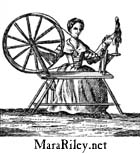
Shift styles changed over the course of the 18th century, with very full elbow-length sleeves until the middle of the century. For example, look at the shift sleeves in a detail from The Stolen Kiss by Fragonard. The sleeves are full, elbow-length, and have a narrow cuff. In the second half of the century, shift sleeves trended toward increasingly narrow sleeves following the fashion for tighter sleeves in ladies' gowns and jackets, becoming very short and close-fitting in the 1790s to match short-sleeved Empire styles.
You can put ruffles on your shift at the neckline and cuff, but a common mistake is to put too deep a ruffle on the shift's neckline–the ruffles that show up in portraits tend to be no bigger than an inch and a half at most, and they don't show up often in pictures of lower-to-middle class women. Personally, I find that ruffles get in the way when I'm working in camp, so none of my shifts have them. The deep ruffles worn at the elbow (called engageantes) for more upscale dress were usually merely basted to the gown's sleeve so as to be detachable for laundering. Other detachable ruffles ('tuckers') were worn at the neckline for fancy dress occasions when a neck-handkerchief would not be worn.
The shift should be somewhere between knee and calf-length, so that it doesn't peek out from beneath one's petticoats.
Don't wear your shift too high around your neck. It should be low enough to show your cleavage; this is how it's worn in period pictures (about an inch above the top of the stays, more or less). For modesty during the day, women in the 18th century wore a neckerchief, which is a piece of cloth about 33" square, pinned or knotted in front. For evening wear, one's cleavage could show, or one could wear a tucker (as above) for a little additional coverage. The instructions below should make a shift that does not require a drawstring. Shifts either with and without drawstrings were worn in the 18th century; many reenactors find that a neckline that is cut too generously will cause the shift to slide off one's shoulders.
Note: A nursing mother asked me whether the instructions below will give a neckline large enough to permit her to breastfeed her son. I suspect the neckline as drafted below might be a little too tight for this. To adjust the neckline, one could either cut the front just a little larger and use a drawstring to make it fit, or make a 3" slit in the center front of the neckline, rolling the edge and finishing it like the front slit in an 18th c. man's shirt. The slit is then tied closed at the top with two narrow linen ties. There is a shift on P. 41 of Linda Baumgarten's What Clothes Reveal which has a slit of this sort. The shift is dated to the mid-18th century, with alterations made in the last part of the century. I don't know whether the nursing slit is part of the later alteration or was incorporated into the design when the shift was first made.
How to measure and draft an 18th c. shift (click on thumbnail to see
full-size drawing):
Patterns include:
- Janice Ryan’s
Basic Six Piece Wardrobe Pattern
- Kannik’s Corner
Women’s Shift pattern
- Online
pattern and instructions from marquise.de
You can also find excellent instructions for making shifts, stays, petticoats,
and many other items in Tidings
from the 18th Century by Beth Gilgun, a book I'd recommend to
any beginning reenactor.
Materials:
I made my 'first draft' of a shift from 100% cotton broadcloth (white)–this
was before inexpensive linen was available online. I wore my cotton shift
for a year, then made a second shift of linen, incorporating a few changes
for a better fit and eliminating the ruffles, which tended to get wrinkled
too quickly and get in the way when cooking, etc.
I would recommend buying linen for your first shift and not bothering with cotton. Linen breathes better than cotton does, and it's generally more correct for most 18th century shifts–linen stands up to repeated washings better than cotton, and was generally less expensive than cotton until the advent of the cotton gin and large-scale industrial cotton production in the early 19th century, so people seem mostly to have used linen for undergarments that wouldn't have been seen. Also, use white or greige (unbleached) cotton or linen–linen, even if originally natural-colored, would have become white from repeated washings and bleaching. There are some references to women wearing shifts with the body made of unbleached linen and the sleeves made of a finer, white linen, to save money. I definitely don't recommend a cotton/poly blend, since it doesn't breathe well in hot weather... and believe me, you want to be as cool as possible at reenacting events.
Details:
Cuffs should be closed with thread buttons or a ribbon through the buttonholes.
Thread buttons can be obtained from Wooded
Hamlet Designs. Drawstrings could be silk ribbon or linen or cotton
tape.
Linen can be obtained from various sources online:
Fabrics-store.com, which has
good quality fabrics at reasonable prices
Fabricclub.com
Burnley & Trowbridge has handkerchief-weight linen, well worth the extra expense if you're making a fine shift.
Also see this shift from the collection of the Museum of Fine Arts, Boston
For other suppliers, see the Patterns and Resources page.

